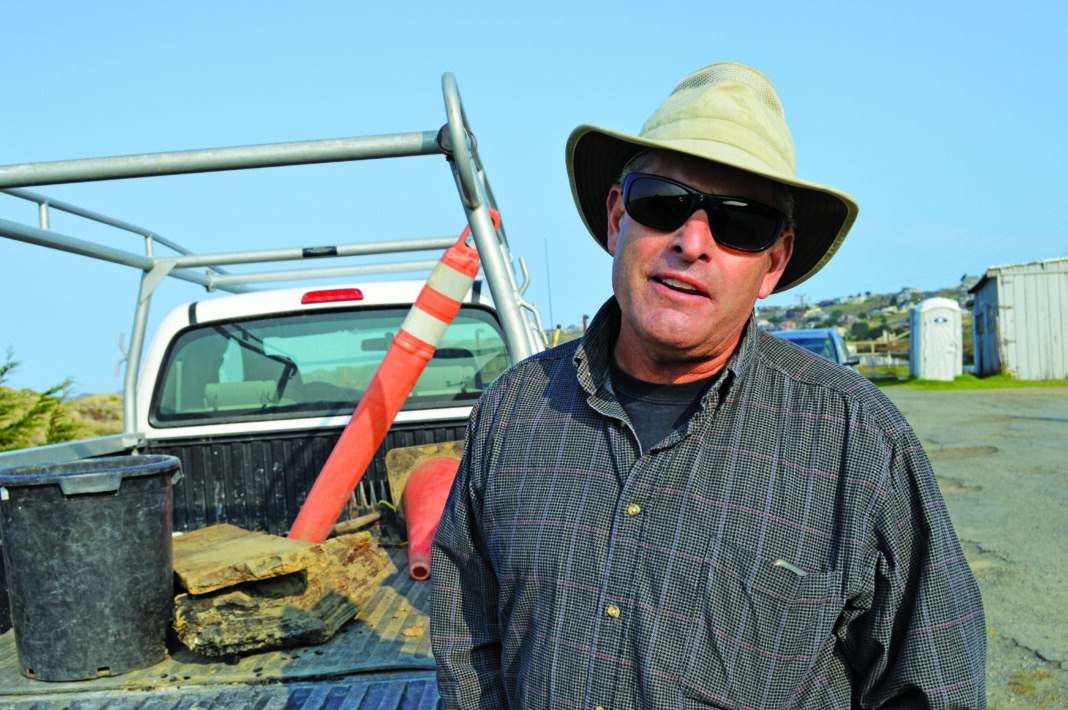Last week I jumped in the car on a breezy morning and headed up Highway 1 (“The One,” see Letters) to Lawson’s Landing in Dillon Beach to try and figure out just what the heck is going on at the campground, which recently lost in the latest vote taken by the California Coastal Commission (CCC) over its land-use plan.
I spent the morning with Marin-based attorney/consultant Tom Flynn and the affable Mike Lawson, a co-owner of the grounds, touring the acreage and getting the explainer on their plan for a new wastewater system, after their latest plan for the system was shot down by the CCC.
To hear the pro-Lawson’s forces tell the tale, Lawson’s has been working to come into compliance with various upgrades and demands to the facility since 2008, when the Environmental Action Coalition (EAC) of West Marin, based in Point Reyes Station, appealed a Marin County Supervisors’ decision to approve low-cost camping on about 90 acres in the 950-acre spread. Lawson’s has been in operation since the 1950s and mostly serves a client base of out-of-town campers rolling in from the hot and bothered Central Valley.
A new Coastal Development Plan (CDP) was submitted and approved by the CCC in 2011, but pro-Lawson’s advocates now say the approval was vague insofar as what it required of Lawson’s. Over the next six years, the family set out to work with the EAC and the CCC to accommodate the demands, says Flynn. The transition at Lawson’s appeared to reach its most physically obvious and painful nadir when the Lawsons removed the last of the funky old legacy trailers from the site in 2016.
Scott Hochstrasser, a former Marin County environmental review officer, submitted a letter to the CCC that summed up the history at Lawson’s to date, and the pro-Lawson’s frustration at the EAC. The California Coastal Act that gave rise to the CCC required that localities come up with Local Coastal Programs, and back in 1981 Marin County’s Local Coastal Program was approved. Hochstrasser wrote that Lawson’s was “an appropriate place for expansion of visitor-serving facilities including overnight camping and boating, providing appropriate environmental resources were protected and sewage disposal facilities were improved to State Regional Water Quality Control Board standards.”
To hear Flynn and Lawson tell it, there’s kind of a “move the goalposts” dynamic that they’ve been dealing with insofar as the environmental community. The latest setback for Lawson’s ensued after the CCC voted 3-2 against a wastewater treatment plan that was prepared by the hydrologist who was recommended by the EAC, says Flynn. At issue in the latest ruling, is the fate of a resident population of endangered California Red-Legged Frogs, and making sure a wastewater system doesn’t mess with their habitat. Flynn says the wastewater plan was supported by CCC staffers but that a push from local environmentalists swayed a few of the commissioners.
In his letter to the CCC, Hochstrasser accused the EAC of setting out to “exclude rural property owners from succeeding to provide low-cost, visitor-serving recreational opportunities on coastal lands for future generations who live outside of Marin County.”
The EAC has a rather different view of things. Executive Director Morgan Patton notes that the latest offering from Lawson’s had two problems—the frog corridor in light of a proposal to build some new buildings along with the wastewater infrastructure, and the other, she says, was pegged to a conflict resolution process that’s enshrined in the Coastal Act. That was done in 2011, she says, when Lawson’s was given permission to develop recreational camping in wetlands areas, and also agreed to build-out a new wastewater system.
“The EAC has worked with the Lawsons along the way,” says Patton, strongly dismissing any suggestion that her organization is trying to drive them out of business, “and we are supportive of what they are doing. We just want to make sure it’s in the appropriate place that’s not damaging the habitat.”
Patton says that the EAC is simply trying to hold the Lawsons to the agreement they signed in 2011. “It’s not moving the goalposts,” she says, “it’s looking at the CDP.”











